New ACK E-04 406Mhz ELT with GPS
Added 5/8/2011This one falls in the "Better late than never" category!
Most people know that as of Feb 1, 2009, the 121.5MHz and 243Mhz emergency beacons, and ELT's will no longer be monitored by any of the authorities. The world has switched over to 406Mhz for both PLB's and ELT's, due to the awful poor amount of accuracy in locating people by RF signal alone on the old 121.5MHz frequency. The satellites monitoring by COPAS-SARSAT, it is said, are now able to zero in much more accurately, 2-5km versus 25km, to the position of the beacon. Add to that the fact that many ELT's and PLB's will actually have GPS's built-in or integrated, and can report your PRECISE location, within feet, when activated! This means that when you actually need to be found, you can be found in minutes, not hours or days or never, provided you activate your PLB or your ELT automatically activates. There have already been documented cases of rescues that were extremely fast, simply from having such accuracy.
Seeing that this was coming, and always wanting to be as rescue-able as possible, back in 2007, I noted in my Vegas/Nellis Write-up, that I purchased a 406MHz GPS enabled PLB made by ACR. This has been carried on-board ever since, but we've never had to use it. On our Bahamas trips especially, it's been comforting to know we had the PLB, and we carried it on our person during water crossings. Other countries have already started banning 121.5MHz ELT's, but today, it's still legal to have and use them in the USA....not that it will do you any good.
I've also really enjoyed having APRS, the free, Ham Radio type tracker, on board for all my trips, giving just one more way that we may be possibly found in an emergency....although this does not, and should not, be a substitute for a PLB and ELT. APRS will probably NOT help you once you're actually too low for signal coverage, and it will still leave a large search area. Besides that, it isn't likely to survive a crash, and be operational, as a PLB would be. It is, however, one more good thing to have, as would be a SPOT messenger or new SPOT Connect, if you feel like paying an annual fee (I don't). APRS provides superior resolution for tracking, whereas SPOT provides superior coverage but poor resolution.
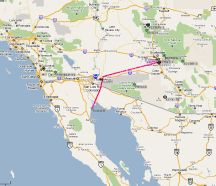
But back to ELT's....
So 406MHz ELT's are really the only practical way to go these days, especially if you want to be found in the event of a crash. With kids on board, I sure as heck want help to come quick. 406MHz ELT's have been around a long time now, but the big problem with them has been their price. Most of them were near $1000 for the ELT, and if you wanted the added ability to have GPS integration (which in my opinion would be silly not to have), you had to pay even more money. I knew there would be cheaper alternatives, but they weren't about to be released initially....you had to wait until finally the 121.5's were gone, and the companies started competing for customers for their 406Mhz alternatives.
Enter the ACK E-04
So maybe around a year and a half ago I ran across the fact that Ack Avionics (maker of my present Altitude Encoder), would be making a new model, the E-04, that would be available as a retrofit to their E-01, or a complete package, with an MSRP of $599, and that is COMPLETE with GPS integration! This sounded perfect! Yeah, $599 is still a bit pricey, but at least at this point, you're buying something that is clearly far superior in both features and abilities to the 121.5MHz versions, so you're getting far more for what you pay for. I found initially that I couldn't put in an order, because they weren't taking any orders directly, and weren't ready to place pre-orders. They were still going through the VERY length beaurocratic process of certification and approval, which drove the timeline into endless delays. Finally, in late 2009, they started to accept pre-orders for a while, and I immediately called one of their distributors, Dallas Avioinics, and had them put my name on the list. I ended up being #8 on the Dallas Avionics pre-order list.
Finally, the day came that they were approved, and they started shipping. First, they shipped the first 20 or so units to people local to them, that volunteered to provide immediate feedback regarding the installation and performance. Apparently they had a couple of issues with faulty self-test reports of "low RF power" (3 beeps when testing). Being that I was in the front of the pack, I was affected by this too. It is a bogus failure message in that they knew for a fact that output power was fine, but due to some component tolerance + installation effects, it could trigger RF to be induced that wasn't adequately filtered out and would trigger the failure, or at least that's what they told me. When I did my install, it tested with that failure, so I sent it to them right away, and they did a same-day fix and turnaround, saying they had to change 1 or 2 minor components (capacitor and resistor?) for better filtering. They tested it again, and it worked fine, so they sent it back right away and I found it all worked great now. I'm not sure if this is going to be more common or not, but being at the front of the pack has always had it's downsides for me, and I'm used to finding these things in new products, so I wasn't surprised. From the sounds of it, it should be a rare thing.
Now, onto the installation
First let me note that the non-retrofit version (i.e. Full version) is 100% complete and not much more money than the retrofit version, so unless you own an ACK E-01, I'd recommend just buying the full version, which looks to be selling between $580 and $599. This will give you all the mountings and everything else you need other than batteries.
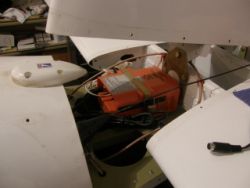
|
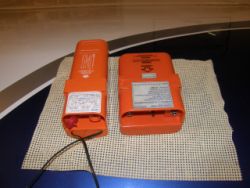
|
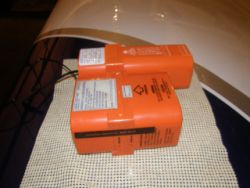
|
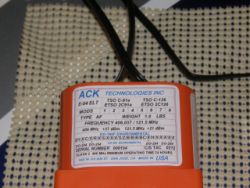
|
First you'll note above the picture of my original AmeriKing ELT. It fit nicely right in front of the spar on the horizontal stabilizer, and between the 2 trim cables for the elevator trim. Seeing them side by side, you can see that the ACK is both much narrower, but longer. This proved to make the installation in my particular mounting location, a bit more challenging. The length caused the ELT to not fit between the 2 trim cables, so, if you see in the photo below, I had to build "legs" for the ELT tray. I was going to build them out of simple hard aluminum tubing cut to 1" length, and bolt the tray down, but my supply of aluminum tubing was short, and I wanted a little larger footprint anyway, so I made them out of some very high density but yet light weight plastic blocks that I had around the garage. This elevated it to allow me to mount it in the same location with no problem. The remote control unit in the panel was an *almost* direct replacement. Turns out the holes were just slightly spaced a little closer vertically than the AmeriKing's remote (you CAN use the AmeriKing remote with the ACK, but I chose not to, wanting to go with "all new" parts). By slightly oblonging the holes though, the remote fit right in. The ACK also comes with an audible alert module that gets mounted behind the panel with velcro that provides audible alerting when the ELT is going off. I'm sure that it would work without it, but it is small and it was part of the install manual to install it, so wanting to comply, I did. I purchased new batteries, as no batteries other than the main battery are provided. The audio alert module uses a 10 year lifetime Lithium CR-2 Battery, and the remote unit uses a 10 year lifetime Duracell PX28L battery. The two items that were NOT provided, that I needed in my install, was an RJ-11 coupler (the same type of coupler you'd use to join two telephone cords), and a computer hard drive jumper. Let me elaborate on the first one here, and the hard drive jumper later, during GPS integration. In the ACK E-04 package comes a telephone cord with a male RJ-11 plug on one end, and a female jack on the other end. A male plug on the ELT plugs into the female jack, and essentially turns the entire thing into just a simple long extension phone cord. It keeps the Black,Red,Green,Yellow wires all in the same orientation as you compare the male plugs. Well, in my AmeriKing installation, they use a Male to Male RJ-11 cord instead. I wasn't about to try to pull a new phone cord all the way through from tail to panel, when my original cord could be made to work fine, but it did take a bit of work. In order to make it work, you need to do 2 things: 1) purchase a simple RJ-11 coupler....I used the Radio Shack 279-013, since it was the smallest and doesn't have any wires inside, just the gold plated spring metal contacts. 2) You need to cut the end off the male end of the cord and install a new end upside-down. Let me explain that second point even further... I could visually and electrically test my coupler and looking at the wire plugging in to each side, could see that I would be mating my B/R/G/Y cable to the other cable that was Y/G/R/B.....so my wires were "rolled" in orientation to eachother. RJ-11 plug ends are dirt cheap, and I already own an RJ-45 and RJ-11, crimper, being a network dude, so by cutting off the end, and installing the new one flipped upside down, I could make the cable coming in B/R/G/Y come out B/R/G/Y on the far end of the cable too, maintaining a continuous Black to Black, Red to Red, Green to Green, and Yellow to Yellow, over the entire length...that's all from just cutting off one end...say it's tab-up if you face it, and flip it to tab-down. That's all it takes. It's simple, cheap, and saved me from having to pull a whole cable through and disassemble the plane and cut all sorts of zip ties. Here's a good link if you want to see pinouts: http://www.allpinouts.org/index.php/RJ11_Telephone  With that end cut off and reinstalled, I now had the proper cable, and my original new cable from ACK is still in it's package. If I were building new, I'd just pull their cable. I'm assuming other couplers would be like mine, but you may want to electrically test whatever coupler you buy and verify how it connects. On mine, pin 5 would connect to pin 2, pin 4 would connect to pin 3, pin 3 would connect to pin 4, and pin 1 would connect to pin 5, as it went from one male connector to the other, since the tab locks would both face the same direction as you stick these 2 connectors face to face. Maybe some couplers would be wired "rolled" like that and save you the trouble, but either way it's worth ohming them out to test them. I was made aware that I may have to reverse this end by calling ACK before it was even delivered, so I was prepared. |
|||
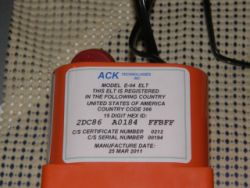
|
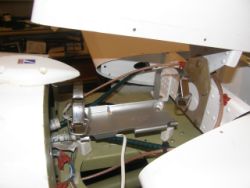
|

|
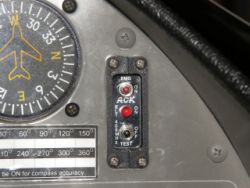
|
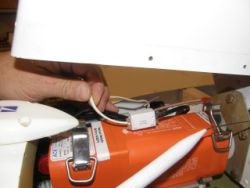
|
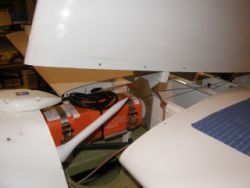
|
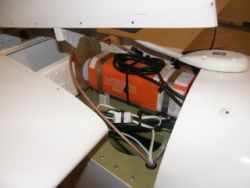
|
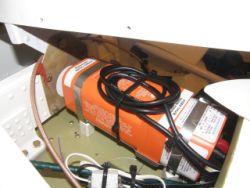
|
So as you see from above, I had the coupler installed, the ELT mounted, the antenna placed, and all was fit. If you want to know what all that stuff is, the GPS antenna in the back that fits under the fairing for my Vertical Stab is for the NavWorX ADS-B....I didn't want to cut a hole in the upper deck for it at the time, so I mounted it there, in case it was temporary. It's worked perfectly so I left it there. No, it's not attached by all screws, but the fairing holds it down, and it's not exposed to the wind, so it works. The ELT antenna is NOT mounted per instructions...they would of course have you mount it on the outside of the plane, pointed vertically. I mounted it on that back bulkhead, facing aft, supported by a tie-wrap and base, so that it doesn't bang around in there. A long time ago I heard someone say "when you crash, do you plan to crash with the antenna facing up?" and I realized that during a crash it's not likely you'd be pancake flat anyway, and these things transmit pretty powerfully, so I was happy that I could just get it a fairly clear view of the sky, but it isn't vertical. If you don't like it, don't do it that way. All the extraneous wires are bundled up and secured. One other job in this whole project is the GPS integration. The first part of that is installing a mini-DIN type connector on a wire you provide, that runs to your GPS, and +12V/GND. I used shielded cable, and since I didn't have shielded triple, I used shielded quad and snipped off a wire. The plug uses 4 pins...+12V, GND, RS232 Receive, and an output pin that you hook to a test LED that will indicate by flashing the LED that you are getting a good GPS signal. (more on that 4th pin later) This connector gets soldered in, and I was glad I had a nice tiny-tipped professional soldering iron, because it's delicate soldering. |
|||
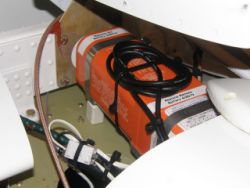
|
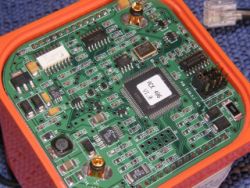
|
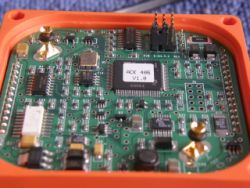
|
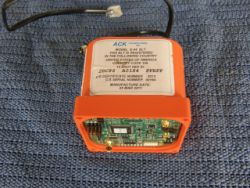
|
GPS Integration
For a long time now I've lived with poor GPS integration on my APRS tracker. The issue is, I'm a cheapskate sometimes, when it also involves solving a problem I'm not ready to tackle. In my case, when it came time to put in the APRS, I didn't want to put a GPS antenna on the upper deck, but I DID want to belly mount a whip for the transmitter. This gave me the tailcone next to the battery as the mounting location....but unless I put a GPS in the wingtip, I had no good way to put in another GPS feed. My Pinpoint GADAHRS for the Chelton system is right back in that same area, and it has a GPS in it. So, I tapped into that line and fed my APRS with the GPS from my primary flight system. This GPS I had was RS232 at 9600 baud, so I also had to get a newer version of APRS firmware at the time, that would allow me to run at 9600 baud, as most APRS transmitters want(ed) 4800 baud GPS. But, it worked, and saved me wiring in and powering another GPS. There was one other downside as well....the GPS I was using didn't transmit altitude. It was a NMEA-0183 format GPS, and the ACK E-04 can use both Aviation and NMEA-0183 type GPS's, but my APRS transmitter could only use NMEA-0183. So when it came time to send GPS to the ELT, I could have left my APRS as-is, and pulled a wire to my GNS-480 and fed the ELT it's Aviation format GPS, but I didn't really want to wire anything to the connectors on the GNS-480, and I really DID want to get an altitude sending GPS for my APRS as well....so that family tracking me could tell when I was descending. So this was the perfect opportunity for me to do some extra work, and get a new GPS installed that would work with my ELT and APRS. It would also allow me to clip the wire using GPS from my GADAHRS, so that if my ELT or APRS had some sort of failure, it wouldn't be at all tied to my flight display, which is a good thing too. The only real complication is that I would have to now finally mount a GPS in the wingtip if I wanted it concealed and away from other things, and that meant only a small area (about 1 sq.ft.) of area in the wingtip as ok mounting area if I wanted to keep it under the white, non-metallic painted areas. No big deal. I did a bunch of research and digging online for a good GPS, and knew I was looking for something pretty simple, but I wanted a good performing GPS. The Sirf 3 chipset GPS's seem to be very very good performing and highly sensitive, so I went down that path and bought a GlobalSat BR-355 GPS puck, which is only about $35-40....$50 delivered, WITH an RS-232 D-sub cable. (I got it from Semsons, if you're interested). You need a GPS which is a real RS-232 GPS, not USB. This one came RS-232, so it was a good match. The only need for the RS-232 cable is for any configuration changes to the GPS that you want to do. I used it to make sure that WAAS related messages were turned on, but I'm sure that out of the box it would have worked fine as-is. The GPS itself is maybe 2" in diameter, and 1" thick or less. 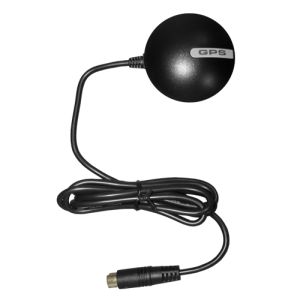 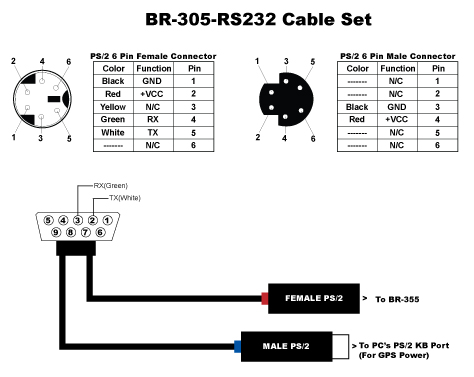 I cut the cable end off and found that although the above end says that the Green wire was "RX" that when hooked to my laptop serial console, I would get data using Black/Red for GND and Power, and Green was transmitting me data. I had a 5V regulator circuit I had made for another airplane project a while ago, so I already had a way to regulate power down to the required 5V for the GPS, so I mounted the regulator and GPS in the wingtip. Regarding the Altitude sending of the GPS, my original GPS transmitted only this one message: $GPRMC,210636.40,A,4453.61237,N,09152.30869,W,0.021,237.31,180411,,,A*7E
$GPRMC,210636.60,A,4453.61236,N,09152.30868,W,0.036,237.36,180411,,,A*7D $GPRMC,210636.80,A,4453.61235,N,09152.30867,W,0.017,,180411,,,A*61 The $GPRMC message doesn't
include altitude, so that's why I never could report my altitude with
APRS. Now, it isn't that I didn't TRY to use that GPS with the
ELT....I did, initially, but the funny thing is, that above $GPRMC also
isn't enough for the ACK ELT...it wants more GPS messages too....so, I
didn't get any blinking LED on my test light (photo below of my test
light), but instead got a solid red light, but only with the test light
hooked up in REVERSE. The reason is, if you don't have valid GPS,
you'll get something like -5.57V on that test wire. If you have valid
GPS, it'll blink with +5V, and between blinks the voltage goes to
-5.57V. So, the GPS from my GADAHRS wasn't going to work anyway.
Here is the GPS output I logged with the GPS from the GlobalSat BR-355, complete with the $GPGGA message that contains the altitude $GPRMC,222706.000,A,4448.4491,N,09142.5949,W,0.32,116.92,260411,,,A*78
$GPGGA,222707.000,4448.4490,N,09142.5948,W,1,09,1.1,264.5,M,-33.7,M,,0000*61
$GPGSA,A,3,23,06,20,16,31,30,13,32,03,,,,2.0,1.1,1.7*35 $GPGSV,3,1,12,23,81,260,42,16,74,079,40,30,51,055,38,13,45,309,36*7C $GPGSV,3,2,12,06,31,129,20,03,28,148,23,20,24,219,29,31,16,082,18*71 $GPGSV,3,3,12,32,16,195,20,10,13,320,,07,11,274,20,19,03,165,*7C $GPRMC,222707.000,A,4448.4490,N,09142.5948,W,0.41,120.23,260411,,,A*72 $GPGGA,222708.000,4448.4489,N,09142.5948,W,1,09,1.1,264.0,M,-33.7,M,,0000*63 $GPGSA,A,3,23,06,20,16,31,30,13,32,03,,,,2.0,1.1,1.7*35 $GPRMC,222708.000,A,4448.4489,N,09142.5948,W,0.04,267.11,260411,,,A*75 The one thing I haven't yet spent time on is the last part that wasn't included in the kit. My GPS was a 4800 baud GPS. Most Aviation GPS's would be 9600 baud, which is probably why they don't supply the jumper. But, in order to receive 4800 baud GPS, you need to jumper 2 pins with a regular .100" (2.54mm) hard drive jumper. See the photos above for where my jumper is placed...jumper info is in the install manual. So, with all that tested and wired, and my ELT back from ACK's quick rework, everything is installed and working great. As a bonus to the delay, I had registered my ELT with NOAA before I sent it back to them, and by the time I had it back in hand, my sticker came from NOAA, so I got to stick it on the ELT....no more pulling that VS fairing for a while! Installation complete, and for FAR less than the original $1000 or greater price tag! |
|||
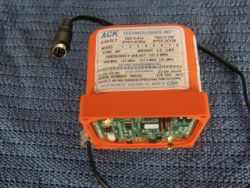
|
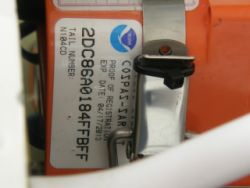
|
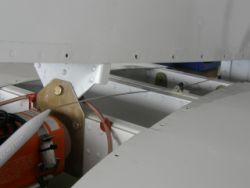
|
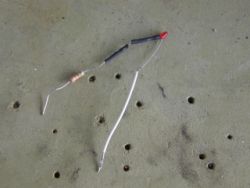
|